
The Sea's Bounty Awaits: Unlocking Bangladesh's Blue Economy
Akhlaqur Rahman Sachee and Syed Md. Rakeen
In 2012 and 2014, Bangladesh resolved two historic maritime disputes with Myanmar and India, respectively, and gained a staggering 118,813 square kilometres of the territorial sea, 200 nautical miles of the exclusive economic zone, and a significant portion of the extended continental shelf in the Bay of Bengal. This opened up an ocean of opportunities for Bangladesh to spread its wings for the blue economy. The blue economy, in general, refers to the utilisation of marine resources through the employment of sustainable practices. This industry holds power to create a transformative effect on the country’s economy. According to World Bank, the industry is valued at USD 6.2 billion for Bangladesh while the United Nations (UN) has estimated its worth to be around USD 3 to USD 6 trillion globally. It possesses the potential to enhance food and nutrition, reduce poverty, create employment opportunities, boost businesses, and maintain regional peace and security while also protecting the ecosystem and biodiversity.
Additionally, the industry is tied to the Sustainable Development Goals, more specifically SDG 14, which focuses on the sustainable use of oceans, seas, and marine resources for development, further emphasising the need to prioritise this industry. The sector’s success will inevitably benefit the people residing in the coastal regions of Bangladesh, resulting in maintaining steady economic growth and propelling the country further towards becoming a developed nation by 2041.
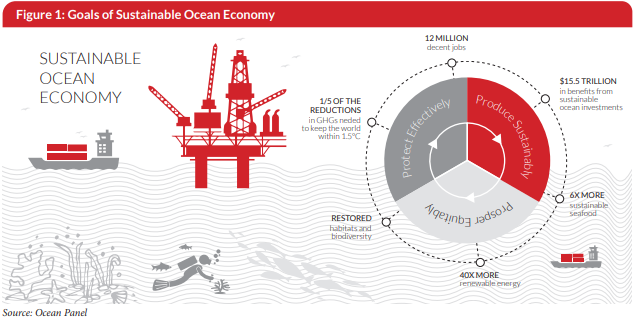
Global Scenario of the Blue Economy
The concept of the “Blue Economy” is creating wonders in some of the world’s most powerful and prominent countries, such as China and the United States, primarily by utilising their ocean and coastal resources. A large portion of the world’s poorest and most vulnerable people rely on the blue economy for daily sustenance. According to the UN, the industry supports up to 237 million jobs worldwide, with over 3 billion people receiving essential minerals and protein from the ocean food business. More than 50% of the populations of the least developed nations receive their proteins mostly from seafood. In addition to safeguarding coastlines from storms and floods, coastal and marine ecosystems provide up to USD 11.5 billion in tourism revenues and serve as habitats for biodiversity, carbon storage, and detoxification.
The UN has stated that the market value of marine and coastal businesses and resources is estimated to be USD 3 trillion annually or around 5% of the global gross domestic product. To uphold this industry, the Lisbon Declaration, comprising 150 countries, was signed to speed up the enhancement of the condition, output, sustainability, and adaptability of the ocean and its ecosystems. As per a report published by the World Economic Forum, China has promised to start 31 marine biological preservation and restoration projects in the next five years, while Kenya has plans for a blue economy bank fund. By 2030, Portugal plans to seek a marine renewable energy capacity of 10 gigawatts, while India has committed to outlawing single-use plastics.
A global ocean innovation ecosystem comprising accelerators, incubators, funds, hubs, clusters, platforms, and contests can support the emergence of hundreds of blue economy enterprises worldwide. Several initiatives have been taken by renowned organisations such as Asian Development Bank (ADB), United Nations Development Programme (UNDP), United Nations Environment Programme (UNEP), regional groups, and national bodies to foster the growth of this untapped industry.
The sustainable blue economy provides attractive returns on investment and a hopeful future while putting indigenous and local people at the centre. The Sustainable Blue Economy Investment Forum at the United Nations Ocean Conference secured billions of dollars in pledges from the public, commercial, and charitable sectors for this thriving industry.

Harnessing the Power of the Blue Economy in Bangladesh
With nearly 710 kilometres of coastline, Bangladesh has tremendous potential in the blue economy, especially in the fields of fisheries, shipping, tourism, natural resources, and oil and gas.
1. Fisheries and Aquaculture
There are three major sub-sectors that makeup Bangladesh’s fishing industry, namely inland capture, inland culture, and marine fisheries. This sector’s prospects are bolstered not only by Bangladesh’s geographic closeness to bodies of water but also by the abundance of seafood and fisheries goods available for export. As per a report published on The Financial Express, there are 500 species of fish alone, including snails, shellfish, crabs, sharks, octopuses, and others. Bangladesh is predicted to capture just 0.70 million tonnes of fish per year of the total 8.00 million tonnes available in the Bay of Bengal. It is worth noting that 15% of protein is obtained from sea resources by individuals worldwide. Since many people rely on the seas for their livelihood and sustenance, more measures are required to conserve ocean resources.
The gradual increase in the production of fisheries over the last 11 years, as displayed below, indicates that the industry is living up to its potential.
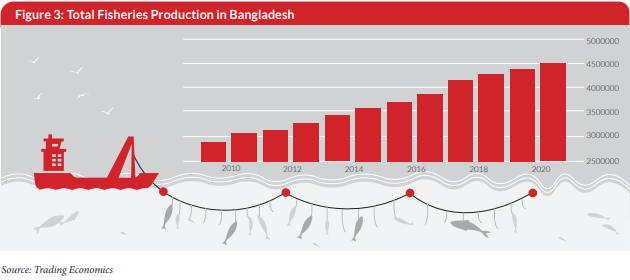
2. Oil and Gas
Bangladesh is yet to determine the actual value of its offshore gas extraction possibilities, with potential gas resources in its marine area. Like Myanmar, Bangladesh may have the potential to develop more gas fields in the sea alongside the inland gas resources, which would contribute to the country’s overall gas reserves. Ocean resources such as oil and gas, sea salt, ocean renewable energy, blue energy, biomass, and marine genetic resources should be preserved to capitalise on the abundance of potential that holds the key to our long-term economic progress.
3. Shipping
Shipping plays a crucial role in the foreign trade of Bangladesh. By facilitating the delivery of commodities to foreign markets, it significantly contributes to the country’s export-driven economy. There are prominent seaports in Bangladesh, notably Chattogram and Mongla, which manage a sizable percentage of the nation’s commerce. To keep the massive amount of freight business within the nation, incentives should be offered to local shipping businesses to add more ships to the existing fleet. Furthermore, coastal shipping services, seaports, passenger ferry services, inland waterway transportation services, shipbuilding, and ship recycling businesses should be prioritised to support our country’s economic progress.
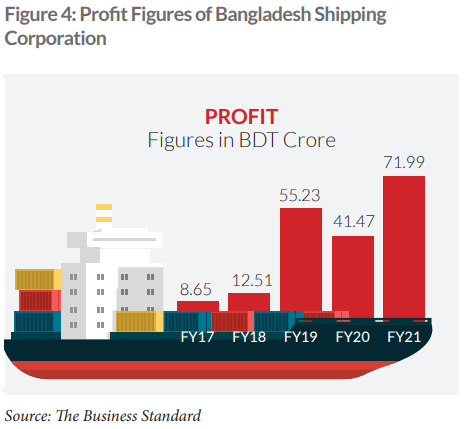
The government-owned agency, Bangladesh Shipping Corporation, has been raking in huge profits each year, as mentioned in the figure above. As of December 2021, the company had eight ocean-going vessels.
4. Tourism
It has been stated in a report published on The Financial Express that coastal tourism is the most significant in the tourism segment, accounting for 5% of the world’s Gross Domestic Product (GDP) and 6% to 7% of total employment. It is among the top five export earners in 150 nations and acts as the primary source of foreign currency for half of the Least Developed Countries (LDCs). Bangladesh, with the world’s longest continuous sea beach and an extensive coastline, offers enormous potential for developing sustainable coastal and marine tourism. So far, the country’s tourist growth has been underperforming compared to the global scale. Effective planning, budgetary allocation, community engagement, awareness building, cooperation between agencies, and proper marketing tactics are all vital components in tourism development.
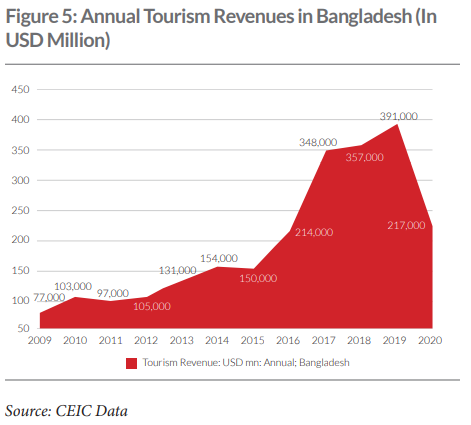
However, in the last 10 years, Bangladesh has made significant strides in terms of revenues in the tourism industry. By improving this sector, Bangladesh may be able to boost its GDP, create more jobs, alleviate poverty, earn foreign currencies, acquire socio-cultural advantages, conserve the environment, and safeguard coastal regions by promoting tourism in marine and coastal areas. Furthermore, by incorporating the local population into the development process, coastal and marine tourism may provide a chance to promote local culture and history. The government may play an essential role in boosting coastal and maritime tourism by offering unique facilities to international tourists, such as on-site visas.
5. Natural Resources
The Bay of Bengal is rich in natural resources. Mineral sands have been discovered in 13 spots on the seabed, as per a report published on the Daily Sun. There are possibilities of discovering uranium, which is a key fuel for nuclear power plants. To accommodate the rising need for electricity, the government of Bangladesh is making investments in alternative energy sources, including nuclear energy, solar, wind, and hydropower, due to the country’s large potential for these energy sources. The discovery of uranium can play a big role here. Bangladesh is looking into the possibility of obtaining more natural resources, including thorium and clay. The continued prosperity of the Bangladeshi economy will largely depend on the discovery and efficient use of these natural resources.
Challenges of the Blue Economy in Bangladesh
While the prospect of the blue economy certainly seems to be on the upswing, it does have its fair share of challenges. To begin with, lack of proper policies along with weak governance could prevent Bangladesh from keeping sustainability at the heart of all the initiatives. It might be challenging to ensure the sovereignty of the entire coastline region and security in the economic zone. As we are yet to incorporate world-class marine tourism, the creation of eco-friendly maritime infrastructure for the sake of sea tourism might take a while. The government will be required to take initiatives to defend the deep-sea and economic zone from international smugglers, drug dealers, and arms traffickers.
Overfishing has emerged as one of the most unsustainable fishing practices in Bangladesh. Another major unsustainable fishing practice is the use of thin mesh nets and explosives. The rising demand for seafood due to the rising population is contributing to growing unsustainable fishing practices. Its harmful effects include destroying the country’s abundant fish supplies along with the deterioration of fish habitats, creating a massive problem for people who rely on this industry. Bangladesh must implement stronger fishing laws and advocate for sustainable fishing techniques and other economic opportunities for fishing communities in order to solve this problem.
The government must maintain an investment-friendly atmosphere in the acquired sea region to make this sector excel. Furthermore, the conservation of mangroves and sea grass would be required. Sustainability should be the utmost concern while formulating policies. Due to the effects of global warming, it is becoming more challenging to maintain the sea level and manage the temperature differences in the environment. As a result, certain problems, such as sea acidification and sea carbon, may arise. The country has yet to delve into a broad array of resources. The absence of sufficient expertise and infrastructure may stymie Bangladesh’s future success in the maritime sector.
Local and international collaborations are required to ensure the adoption and administration of an objective monitoring system to ensure the sustainability of the Bay of Bengal’s marine and coastal ecosystems. This is especially true for nations like Bangladesh, which rely significantly on the coastal and marine environment for food and livelihood. Accurate conservation plans for marine ecosystems and resources must be implemented on a priority basis by Bangladesh if the country plans to reap the benefits in the long term and make this sector a significant contributor to the country’s GDP. Climate change and its consequences along with economic development-induced pollution must be well managed to maintain the health of the Bay of Bengal.
The Bangladesh government has promoted blue development by establishing a permanent maritime boundary with neighbouring nations. Coastal and marine resources, including living, non-living, and renewable resources, have been highlighted as the primary components of Bangladesh’s blue economy. Strengthening trade and commerce associated with the sea and shore and ensuring protection from natural calamities will provide economic rewards for promoting blue development.
In recent years, Bangladesh’s economy has grown significantly due to the country’s rapid industrialisation and the expansion of its service sector. The blue economy too possesses the potential to significantly contribute to economic development and improve the lives of people living in coastal areas of Bangladesh. In order to strengthen this sector, the government will need to address several issues, such as overfishing, erosion of the environment, insufficient financing, a dearth of reliable statistics, and ineffective governance. Strong collaborations between the government, businesses, and communities are required to solve these difficulties effectively with the help of government policies and private-sector investment.
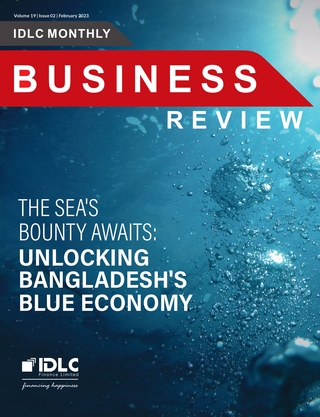
The Sea's Bounty Awaits: Unlocking Bangladesh's Blue Economy
The blue economy concept has become an exhortation for sustainable development through the utilisation of ocean resources for economic growth, enhanced livelihoods, and employment while conserving the health of the environment. According to the United Nations (UN), the industry is worth between USD 3 and USD 6 trillion globally, with its strong ties to SDG-14 (Life Below Water) serving as a crucial reason for elevating this sector.
With around 710 kilometres of coastline, the blue economy offers numerous opportunities for Bangladesh, particularly in the sectors of fisheries, shipping, tourism, natural resources, and oil and gas. The blue economy has the potential to make a substantial contribution to economic growth and enhance the quality of life for the people residing in Bangladesh’s coastal regions.
Expanding ocean-centric industries will bring a new perspective to our economic prosperity. At the same time, the unplanned proliferation of economic activities will be the cause of marine ecosystem deterioration and biodiversity loss, causing significant harm to low-income coastal residents. Understanding and effectively managing the numerous facets of marine sustainability is crucial to reaping the sea’s bounty.
Md. Shah Jalal
Editor
IDLC Monthly Business Review